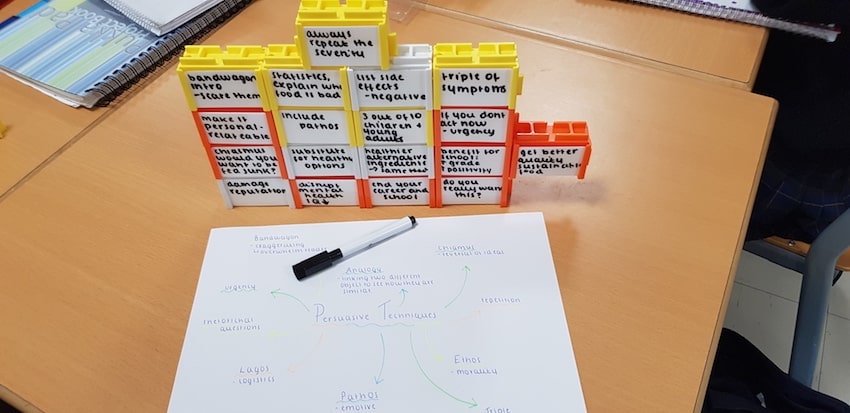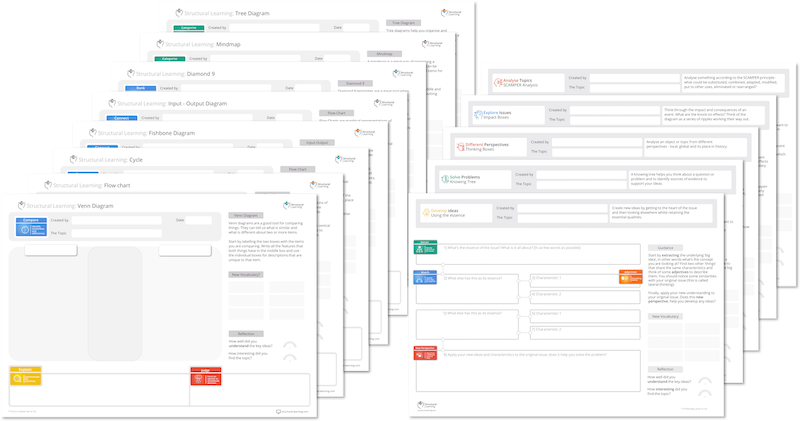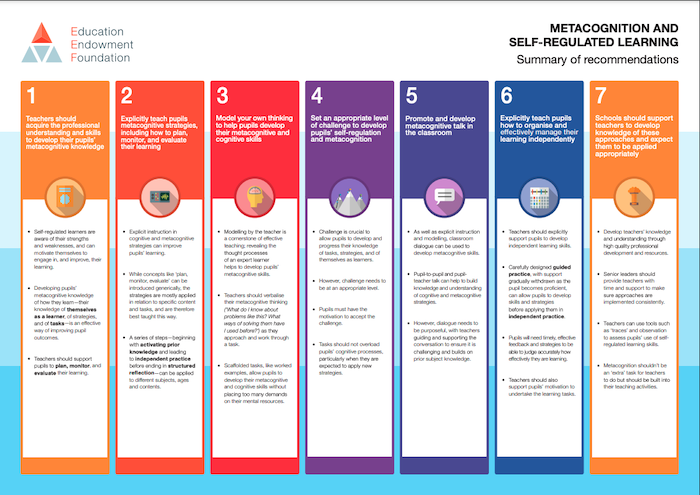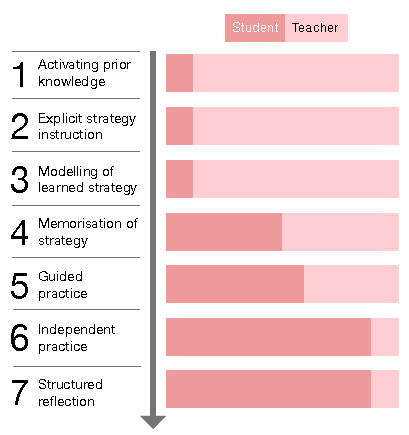Metacognition in Education: Teaching Students to Think About Thinking
Discover how metacognition improves learning outcomes. Learn practical strategies for teaching metacognitive skills including planning, monitoring, and evaluating learning.


Discover how metacognition improves learning outcomes. Learn practical strategies for teaching metacognitive skills including planning, monitoring, and evaluating learning.
Metacognition, the ability to think about one's own thinking, is one of the most powerful tools for improving learning. Research consistently shows that students who can plan their approach, monitor their understanding, and evaluate their strategies are more effective learners. The Education Endowment Foundation rates metacognition as high impact for low cost. This guide explains what metacognition is and practical strategies for developing metacognitive skills in your students.
Metacognition is beneficial in student learning because it allows learners to reflect on what they know, who they are, what they wish to know, and how they can reach that point. Reflection is an important aspect of learning and teaching. Teachers must be reflective in their practice so that they can keep on growing, continue to meet their students’ needs, and evaluate their own growth and skills. It is important to motivate students to practice reflection so that they can build their individual reflective practices and develop metacognitive skills to prepare for their future.
At Structural Learning, we argue that classroom culture is a significant driver for developing metacognitive mindsets. If talking about learning is part of your day-to-day classroom practice then your pupils are halfway there. Developing a healthy balance of both content knowledge and procedural knowledge is a fundamental classroom challenge. We have been helping children develop their knowledge about cognition and how they can manage it more effectively.

Metacognitive knowledge must be built at an early age when children are gaining their primary education (Norman, 2016). The process of Metacognition involves a primary student's planning, monitoring, evaluating and making changes to his individual learning behaviour. Although a typical metacognitive approach focuses on enabling a student rather than the instructor to take control of his own learning, in metacognition, the instructor plays an integral role in developing younger learners’ metacognitive skills. For transforming primary students into metacognitive, self-regulated learners, the primary teachers must:
Using graphic organisers would be an example of active reading strategies. These simple tools can help children develop deeper meaning as they organise their ideas into comprehensive structures. When children are organising their ideas, they are not simply putting information into boxes. The generative learning theory would suggest that students are creating meaning by building comprehensive schemas. These sorts of study strategies are not only powerful but are engaging for the learner.
A cognitive strategy that scaffolds the way children develop deeper understanding are essential for day to day classroom practice. All too often the emphasis in a classroom is on 'getting through the curriculum', take time and give children the opportunity to fully master a thinking strategy.

A well-practiced thinking strategy paves the way for learner independence. Many of our member schools have been utilising the universal thinking framework as a deep-processing strategy. Self efficacy and metacognitive strategies walk hand-in-hand. When a child becomes comfortable with a deep processing strategy such as our mental modelling technique or the universal thinking framework, they begin to understand how learning happens.
When this sort of cognitive strategy becomes a classroom habit you begin to see the implications for building background knowledge and metacognitive knowledge. This reciprocal relationship becomes apparent as children build their repertoire of study strategies.
The use of metacognitive strategies in secondary schools can help enhance secondary students' critical thinking skills, offer them new ways for organizing their thinking in educational tasks, help them distinguish truths and lies told in the media, and teach them about the importance of a growth mindset for success in education and life. The secondary school teachers can apply the following metacognitive strategies to help secondary school students think about their individual thinking processes:

Teachers can develop metacognitive skills in the classroom by offering students the opportunity to implement metacognitive strategies at prime stages of a task. This allows students to improve both their metacognitive abilities and self-awareness to choose an efficient thought process in the future. Somehow, this approach is very much similar to the cycle ‘Plan, Do, Review’ which has been used by a lot of high-performance sports teams. A useful way is to divide the strategies into the following stages:
Through planning before starting a task, students are able to perform their effort more efficiently. Effective preparation involves:
After the task, students need to spend some time reflecting on what they did well and what they should do differently in future. By doing so, students would develop, progress and learn as much as possible from the experience.

Imagine a sportswoman is training for a marathon and her target is to run 24 miles. But, it does not mean she is going to step out of her front door and take off with a steady run at top speed. She would create a plan. She would make a training schedule and she would run in different conditions for different periods of time.
Eventually, she would try and run at that marathon-length route. She may initially fail, or she may not fail. But, that trial run will serve as an opportunity for her to assess what she is doing right in her training regimen and what is not right. Then she would modify her training regimen to suit her needs. This is metacognition.
Students do not usually pause to assess if their routine to study or learn is effective. Metacognition can help them advance the learning process by helping them to assess what they are learning. Are they able to retain the information? Do they need to develop strategies to improve their understanding of a topic? When a student is metacognitive, he understands himself as a learner and then he makes strategic choices about how to study and learn with their knowledge in mind.
How do Metacognitive Processes enhance independent learning?
There is a causal relationship between self-efficacy and metacognitive strategies. Getting better at learning is motivating and understanding a few key cognitive processes sets students up for academic success. Having a metacognitive mindset suggests that someone is willing to entertain the idea that learning is indeed learnable. We can build background knowledge by developing better study strategies. This means that reaching our learning goals is a matter of employing more effective strategies.
Having knowledge of a task will help a student build that all important subject background knowledge. Successful learners invest time in developing procedural knowledge that helps them become independent learners. A metacognitive learner understands that they have control over the situation. Or in other words, with enough of the right sort of thinking any task can be accomplished. Having a range of metacognitive strategies available increases opportunities for learners to develop their independence.
Building subject knowledge independently requires learners to have developed a sufficient amount of procedural knowledge. If a student is unwilling to adopt these types of mindsets then they may see intelligence as fixed. The positive impact that metacognitive practice has in the classroom cannot be denied. As well as developing subject knowledge, metacognition also has a positive impact on intrinsic motivation which is essential when heading into the exam period.

Metacognition or the concept of “thinking about thinking” and was proposed by John Flavell, who is largely considered as a founding scholar of the field of metacognition. According to Flavell, metacognition is related to one's own understanding of his cognitive processes (or his thinking). Flavell (1979) states that metacognition is the ability to control one's thinking processes in several strategies i.e. planning, monitoring, and adapting (Norman, 2016). Moreover, metacognition is a person's ability to reflect upon the processes tasks one performs and to choose and apply the most suitable strategies needed in one's intercultural interactions.

Nelson (2021) mentioned that metacognition is a critical part of successful learning. It involves self-reflection and self-regulation of abilities, weaknesses, and the kinds of strategies one creates. Metacognition provides an essential foundation in culturally intelligent leadership as it affects how one thinks about a situation or problem and the strategies one selects to handle a problem or a situation.
A report has been published by The Education Endowment Foundation on metacognition and self-regulated learning. This report gives examples of strategies that can be used with students of all ages to encourage metacognitive and self-regulated learning in the classroom. These strategies are given below.

Metacognition, or thinking about thinking, is a powerful tool that can enhance learning across various subjects and age groups. Here are nine examples of how metacognitive strategies can be applied in different classroom scenarios:
According to Dr. John Hattie, "Metacognitive strategies can have an effect size of 0.69, which is considered a high impact on student achievement." Furthermore, a study by Bryce et al. shows that explicit instruction in metacognitive strategies can significantly benefit disadvantaged students.
Example: In a cooperative learning environment, a group of secondary students working on a physics project might discuss their understanding of a concept, share different perspectives, and collaboratively decide on the best approach to solve a problem. This process of thinking about their thinking leads to a more profound understanding of the subject.
Key Insights:

1. What is metacognition?
Cognitive processes are the mental processes that involve one's mental state; this can include memory and attention, the activation of prior knowledge, and the use of cognitive strategies to solve a problem or complete a task.
2. What are the benefits of Metacognition?
Metacognition is the ability to monitor and control one's cognition, which is recognized in many scientific fields as the most important component of academic achievement.
4. What is metacognitive regulation?
Metacognitive regulation is the process of monitoring and controlling one's cognitive processes. It refers to how learners manage their mental activities to achieve the desired outcome.
5. What is the planning phase?
During the initial planning phase, learners think about the learning goal set by the teacher. They then consider how they will approach the task and which strategies they will use. You can see examples of how students can approach this here.
6. What is the central executive?
In psychology, the central executive is the part of the working memory responsible for sequential task management.
7. What is the Zone of Proximal Development?
The zone of proximal development is the range of skills that a learner can successfully accomplish with guidance from an instructor or a more capable peer.
8. What is metacognitive development?
Metacognitive development is the development of thinking processes. It's your ability to examine your own thoughts and make judgments about them.
9. What is a metacognitive approach?
A metacognitive approach typically involves students applying metacognitive strategies to respond to clear and explicit learning goals which have either been set by the teacher or identified by the student themselves.
10. What are the benefits of discussing strategies?
The strategy is crucial to the success of the student. Discussing strategies in class helps students understand what strategies are available to them, how they impact their learning and why they work.
11. What are the benefits of metacognitive teaching?
Metacognitive teaching is one of the best ways to teach by encouraging students to reflect on their own learning. It also has other benefits including promoting independent learning.
12. At what age can children become metacognitive?
Several studies have found that children as young as 18 months demonstrated error-correction strategies, and 5-year-olds who were aware of forgetting. Meanwhile, 3 to 5-year-olds exhibited a wide range of verbal skills.
13. What is a Personal Reflection Journal?
The Personal Reflection Journal is an ongoing process that enables learners to document and reflect on their learning process. Learners keep a journal that captures their thoughts, ideas, and reflections on their learning experiences.
Metacognition, the ability to think about one's own thinking, is one of the most powerful tools for improving learning. Research consistently shows that students who can plan their approach, monitor their understanding, and evaluate their strategies are more effective learners. The Education Endowment Foundation rates metacognition as high impact for low cost. This guide explains what metacognition is and practical strategies for developing metacognitive skills in your students.
Metacognition is beneficial in student learning because it allows learners to reflect on what they know, who they are, what they wish to know, and how they can reach that point. Reflection is an important aspect of learning and teaching. Teachers must be reflective in their practice so that they can keep on growing, continue to meet their students’ needs, and evaluate their own growth and skills. It is important to motivate students to practice reflection so that they can build their individual reflective practices and develop metacognitive skills to prepare for their future.
At Structural Learning, we argue that classroom culture is a significant driver for developing metacognitive mindsets. If talking about learning is part of your day-to-day classroom practice then your pupils are halfway there. Developing a healthy balance of both content knowledge and procedural knowledge is a fundamental classroom challenge. We have been helping children develop their knowledge about cognition and how they can manage it more effectively.

Metacognitive knowledge must be built at an early age when children are gaining their primary education (Norman, 2016). The process of Metacognition involves a primary student's planning, monitoring, evaluating and making changes to his individual learning behaviour. Although a typical metacognitive approach focuses on enabling a student rather than the instructor to take control of his own learning, in metacognition, the instructor plays an integral role in developing younger learners’ metacognitive skills. For transforming primary students into metacognitive, self-regulated learners, the primary teachers must:
Using graphic organisers would be an example of active reading strategies. These simple tools can help children develop deeper meaning as they organise their ideas into comprehensive structures. When children are organising their ideas, they are not simply putting information into boxes. The generative learning theory would suggest that students are creating meaning by building comprehensive schemas. These sorts of study strategies are not only powerful but are engaging for the learner.
A cognitive strategy that scaffolds the way children develop deeper understanding are essential for day to day classroom practice. All too often the emphasis in a classroom is on 'getting through the curriculum', take time and give children the opportunity to fully master a thinking strategy.

A well-practiced thinking strategy paves the way for learner independence. Many of our member schools have been utilising the universal thinking framework as a deep-processing strategy. Self efficacy and metacognitive strategies walk hand-in-hand. When a child becomes comfortable with a deep processing strategy such as our mental modelling technique or the universal thinking framework, they begin to understand how learning happens.
When this sort of cognitive strategy becomes a classroom habit you begin to see the implications for building background knowledge and metacognitive knowledge. This reciprocal relationship becomes apparent as children build their repertoire of study strategies.
The use of metacognitive strategies in secondary schools can help enhance secondary students' critical thinking skills, offer them new ways for organizing their thinking in educational tasks, help them distinguish truths and lies told in the media, and teach them about the importance of a growth mindset for success in education and life. The secondary school teachers can apply the following metacognitive strategies to help secondary school students think about their individual thinking processes:

Teachers can develop metacognitive skills in the classroom by offering students the opportunity to implement metacognitive strategies at prime stages of a task. This allows students to improve both their metacognitive abilities and self-awareness to choose an efficient thought process in the future. Somehow, this approach is very much similar to the cycle ‘Plan, Do, Review’ which has been used by a lot of high-performance sports teams. A useful way is to divide the strategies into the following stages:
Through planning before starting a task, students are able to perform their effort more efficiently. Effective preparation involves:
After the task, students need to spend some time reflecting on what they did well and what they should do differently in future. By doing so, students would develop, progress and learn as much as possible from the experience.

Imagine a sportswoman is training for a marathon and her target is to run 24 miles. But, it does not mean she is going to step out of her front door and take off with a steady run at top speed. She would create a plan. She would make a training schedule and she would run in different conditions for different periods of time.
Eventually, she would try and run at that marathon-length route. She may initially fail, or she may not fail. But, that trial run will serve as an opportunity for her to assess what she is doing right in her training regimen and what is not right. Then she would modify her training regimen to suit her needs. This is metacognition.
Students do not usually pause to assess if their routine to study or learn is effective. Metacognition can help them advance the learning process by helping them to assess what they are learning. Are they able to retain the information? Do they need to develop strategies to improve their understanding of a topic? When a student is metacognitive, he understands himself as a learner and then he makes strategic choices about how to study and learn with their knowledge in mind.
How do Metacognitive Processes enhance independent learning?
There is a causal relationship between self-efficacy and metacognitive strategies. Getting better at learning is motivating and understanding a few key cognitive processes sets students up for academic success. Having a metacognitive mindset suggests that someone is willing to entertain the idea that learning is indeed learnable. We can build background knowledge by developing better study strategies. This means that reaching our learning goals is a matter of employing more effective strategies.
Having knowledge of a task will help a student build that all important subject background knowledge. Successful learners invest time in developing procedural knowledge that helps them become independent learners. A metacognitive learner understands that they have control over the situation. Or in other words, with enough of the right sort of thinking any task can be accomplished. Having a range of metacognitive strategies available increases opportunities for learners to develop their independence.
Building subject knowledge independently requires learners to have developed a sufficient amount of procedural knowledge. If a student is unwilling to adopt these types of mindsets then they may see intelligence as fixed. The positive impact that metacognitive practice has in the classroom cannot be denied. As well as developing subject knowledge, metacognition also has a positive impact on intrinsic motivation which is essential when heading into the exam period.

Metacognition or the concept of “thinking about thinking” and was proposed by John Flavell, who is largely considered as a founding scholar of the field of metacognition. According to Flavell, metacognition is related to one's own understanding of his cognitive processes (or his thinking). Flavell (1979) states that metacognition is the ability to control one's thinking processes in several strategies i.e. planning, monitoring, and adapting (Norman, 2016). Moreover, metacognition is a person's ability to reflect upon the processes tasks one performs and to choose and apply the most suitable strategies needed in one's intercultural interactions.

Nelson (2021) mentioned that metacognition is a critical part of successful learning. It involves self-reflection and self-regulation of abilities, weaknesses, and the kinds of strategies one creates. Metacognition provides an essential foundation in culturally intelligent leadership as it affects how one thinks about a situation or problem and the strategies one selects to handle a problem or a situation.
A report has been published by The Education Endowment Foundation on metacognition and self-regulated learning. This report gives examples of strategies that can be used with students of all ages to encourage metacognitive and self-regulated learning in the classroom. These strategies are given below.

Metacognition, or thinking about thinking, is a powerful tool that can enhance learning across various subjects and age groups. Here are nine examples of how metacognitive strategies can be applied in different classroom scenarios:
According to Dr. John Hattie, "Metacognitive strategies can have an effect size of 0.69, which is considered a high impact on student achievement." Furthermore, a study by Bryce et al. shows that explicit instruction in metacognitive strategies can significantly benefit disadvantaged students.
Example: In a cooperative learning environment, a group of secondary students working on a physics project might discuss their understanding of a concept, share different perspectives, and collaboratively decide on the best approach to solve a problem. This process of thinking about their thinking leads to a more profound understanding of the subject.
Key Insights:

1. What is metacognition?
Cognitive processes are the mental processes that involve one's mental state; this can include memory and attention, the activation of prior knowledge, and the use of cognitive strategies to solve a problem or complete a task.
2. What are the benefits of Metacognition?
Metacognition is the ability to monitor and control one's cognition, which is recognized in many scientific fields as the most important component of academic achievement.
4. What is metacognitive regulation?
Metacognitive regulation is the process of monitoring and controlling one's cognitive processes. It refers to how learners manage their mental activities to achieve the desired outcome.
5. What is the planning phase?
During the initial planning phase, learners think about the learning goal set by the teacher. They then consider how they will approach the task and which strategies they will use. You can see examples of how students can approach this here.
6. What is the central executive?
In psychology, the central executive is the part of the working memory responsible for sequential task management.
7. What is the Zone of Proximal Development?
The zone of proximal development is the range of skills that a learner can successfully accomplish with guidance from an instructor or a more capable peer.
8. What is metacognitive development?
Metacognitive development is the development of thinking processes. It's your ability to examine your own thoughts and make judgments about them.
9. What is a metacognitive approach?
A metacognitive approach typically involves students applying metacognitive strategies to respond to clear and explicit learning goals which have either been set by the teacher or identified by the student themselves.
10. What are the benefits of discussing strategies?
The strategy is crucial to the success of the student. Discussing strategies in class helps students understand what strategies are available to them, how they impact their learning and why they work.
11. What are the benefits of metacognitive teaching?
Metacognitive teaching is one of the best ways to teach by encouraging students to reflect on their own learning. It also has other benefits including promoting independent learning.
12. At what age can children become metacognitive?
Several studies have found that children as young as 18 months demonstrated error-correction strategies, and 5-year-olds who were aware of forgetting. Meanwhile, 3 to 5-year-olds exhibited a wide range of verbal skills.
13. What is a Personal Reflection Journal?
The Personal Reflection Journal is an ongoing process that enables learners to document and reflect on their learning process. Learners keep a journal that captures their thoughts, ideas, and reflections on their learning experiences.